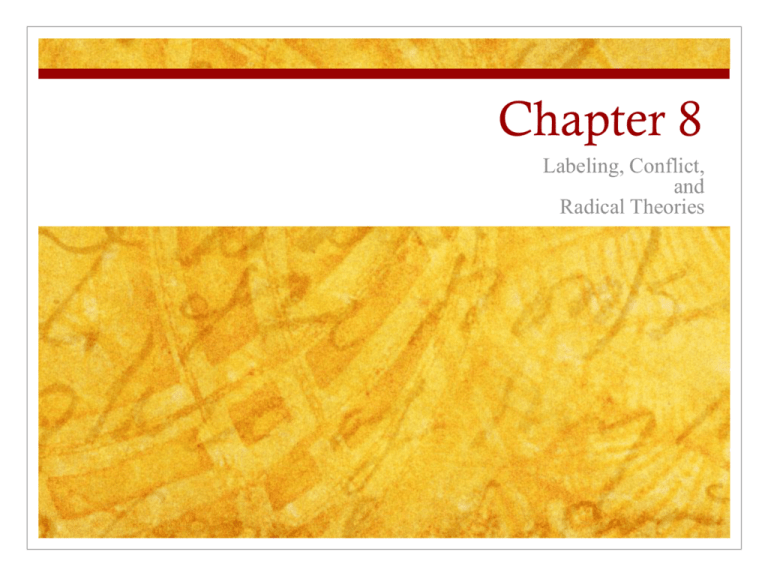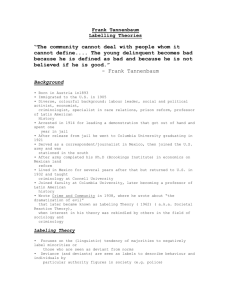
Chapter 8
Labeling, Conflict,
and
Radical Theories
Labeling Theory
The Origins of Labeling Theory
1.
Labeling theory emanates from a group of scholars known as
social interactionists, who viewed the human self as formed
through a process of social interaction.
2.
George Herbert Mead focused on the social interactions by
which an individual becomes a deviant.
Our self-concept is built no only on what we think of
ourselves but also on what other think of us.
Copyright © 2007 by The McGraw-Hill Companies, Inc.
All Rights Reserved.
Labeling Theory
Labeling theorists began to explore how and why certain acts
were defined as criminal or deviant and others were not, and
how and why certain people were defined as criminal or
deviant.
Labeling Theory declares that reactions of other people and
the subsequent effects of those reactions create deviance.
Deviance is not the result of what people do, but rather how
society reacts to those actions.
Copyright © 2007 by The McGraw-Hill Companies, Inc.
All Rights Reserved.
Edwin Lemert
Basic Assumptions of Labeling Theory
Lemert contended that there are two kinds of deviant acts:
Primary deviations: the initial deviant acts that bring on the
first social response; these acts do not affect the individual’s
self-concept.
Secondary deviations: the acts that follow the societal
response to the primary deviation; these acts result from the
change in self-concept brought about by the labeling process.
Copyright © 2007 by The McGraw-Hill Companies, Inc.
All Rights Reserved.
Primary and Secondary
Deviations
1.
A youth commits a simple deviant act (primary deviation)
2.
There is an informal social reaction
3.
The youth continues to break rules
4.
There is an increased social reaction
5.
The youth commits a more serious deviant act
6.
There is a formal reaction
Copyright © 2007 by The McGraw-Hill Companies, Inc.
All Rights Reserved.
Primary and Secondary
Deviations Continued
7.
The youth is now labeled “delinquent” by the court and
“bad” by the neighborhood
8.
The youth begins to think of himself as delinquent
9.
The youth commits another, yet more serious, deviant act
(secondary deviation)
10.
The youth is returned to juvenile court and has more
offenses added to his record, is cast out further from
conventional society, and takes on a completely deviant
lifestyle
Copyright © 2007 by The McGraw-Hill Companies, Inc.
All Rights Reserved.
Edwin Schur
Edwin Schur expanded on Lemert’s secondary deviance
and argued that “the effects of the labeling process are so
significant that even those who wish to leave a deviant
group and return to a conventional life find it difficult to do
so”
the stigma carried by the deviant individual tends to
separates them permanently from mainstream culture
Copyright © 2007 by The McGraw-Hill Companies, Inc.
All Rights Reserved.
Howard Becker
Who makes the rules?
Howard Becker claimed that “moral entrepreneurs” are
responsible for making the rules that define deviant
behavior, including crime.
Moral Entrepreneurs: people whose high social position
gives them the power to make and enforce the social rules
that all members of society have to live by.
The members of society that make the rules which define
what is deviant and criminal create “outsiders” (deviants)
Copyright © 2007 by The McGraw-Hill Companies, Inc.
All Rights Reserved.
Consensus Model
The model assumes that members of society by and large
agree on what is right and wrong and that law is the
codification of these agreed-upon social values.
The law is the mechanism to settle disputes that arise when
individuals stray too far from what the community
considers acceptable.
Copyright © 2007 by The McGraw-Hill Companies, Inc.
All Rights Reserved.
Emile Durkheim
“We can ...say that an act is criminal when it offends
strong and defined states of the collective conscience.”
When members of a society unite against a deviant they
reaffirm their commitment to shared values.
Copyright © 2007 by The McGraw-Hill Companies, Inc.
All Rights Reserved.
Conflict Model
The model assumes that laws do not exist for the collective
good; they represent the interests of specific groups that have
the power to get them enacted.
The key concept in conflict theory is power. The laws thus
have their origin in the interest of the few; these few shape
the values, and the values, in turn, shape the laws.
Labeling theorists concentrated on the crime, conflict
theorists question the system itself.
Copyright © 2007 by The McGraw-Hill Companies, Inc.
All Rights Reserved.
Conflict Theory and
Criminology
George Vold was the first theorist to relate conflict theory to
criminology.
Society is in a constant state of conflict, “one of the principle
and essential social processes upon which the continuing
ongoing of society depends.”
Conflict theory holds that the people who posses the power,
work to keep the powerless at a disadvantage.
Copyright © 2007 by The McGraw-Hill Companies, Inc.
All Rights Reserved.
Radical Theory
Karl Marx
Georg Rusche and Otto Kirschheimer
Taylor, Walton, and Young
Richard Quinney
William Chambliss and Robert Seidman
Copyright © 2007 by The McGraw-Hill Companies, Inc.
All Rights Reserved.
Emerging Explanations
Radical Feminist Theory
Left Realism
Abolitionist and Anarchist Criminology
Peace-Making Criminology
Copyright © 2007 by The McGraw-Hill Companies, Inc.
All Rights Reserved.
Comparison of 4 Criminological
Perspectives
Copyright © 2007 by The McGraw-Hill Companies, Inc.
All Rights Reserved.





